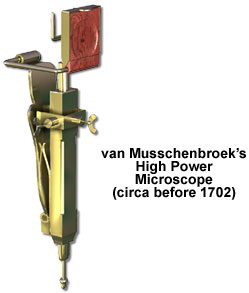van Musschenbroek's High Power Microscope
During the early years of the eighteenth century, Dutch instrument maker Johan Joosten van Musschenbroek designed a sophisticated (for the period) high power brass simple microscope with an adjustable fine focus. The microscope illustrated below resides in the Billings Microscope Collection at the National Museum of Health and Medicine at Walter Reed Army Hospital in Washington, D. C.

Van Musschenbroek's high power microscope used a brass plate attached by a double screw hinge to a brass stem as a specimen holder. This design allowed one of the screw adjustments to change the distance between the plate and the stem, while the other screw moved the plate sideways in front of the single lens.
The instrument illustrated above has a solid brass stem that is three inches long, with a brass plate attached to the stem on a double hinge. Attached to the stem is a steel spring that acts against the plate and holds the stem against a screw. The objective is housed in a block attached by a double hinge to the front of the plate. Specimens are supported by a single spike that fits into a hollow rod passing through a longitudinal hole at the axis of the stem. The objectives are mounted between thin brass plates, which are riveted and soldered together to fit into a dovetail at the rear of the block.
A small box constructed of blackened sheet brass slides on a wooden block that contains the lenses. The bottom section of the box is opened to enable the stem supporting the specimen to be placed inside. Opposite the lens is a large hole in the rear of the box that is fitted with a brass diaphragm having apertures of varying sizes. This crude condenser apparently represents one of the earliest known provisions for controlling the amount of specimen illumination.
Like many of the microscopes developed early in the 1700s, the van Musschenbroek microscope focused on a specimen by moving it back and forth in front of a fixed lens. The major difference was that this microscope was more precise because it employed two screws to move the arms that served to focus the specimen. Van Musschenbroek's design set a basic construction plan for many high power microscopes to follow, and was later refined into what became known as the compass microscope.
BACK TO EIGHTEENTH CENTURY MICROSCOPES
